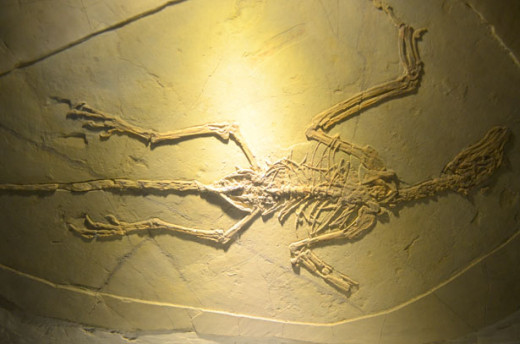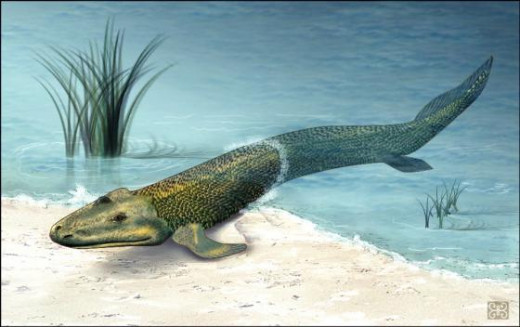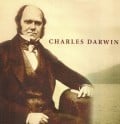The Fossil Record and Evolution
Fossils play an incredibly important role in providing evidence for evolution, the theory that life on earth evolved from one initial organism and has continued to branch out over time through natural selection, giving rise to many species. A fossil is made when a dead organism sinks to the bottom of a body of water and is quickly buried. The hard parts of the dead organism, like teeth and bones, become infiltrated by dissolved minerals, which then are compressed by the sediments piled on top of it (Coyne 21-22). By examining these fossils, scientists can figure out what an ancient organism looked like, how old it is, and what species it may have been related to, which can give clues to where it fits in the evolutionary tree of life.

When it comes to understanding evolution, fossils are some of the most valuable tools we have.
Fossils give us a great deal of insight into what happened in the past and allow us to have a visual representation of what the world looked like millions of years ago. Although scientists estimate that they “have found fossil evidence of only 0.1 percent to 1 percent of all species”, there is still enough to give us a general idea of how major groups split over time and how evolution shaped life as we know it today (Coyne 22). Charles Darwin, author of On the Origin of Species, a very influential book about evolution, noted that fossils found in adjacent layers of rock were more similar to each other than they were to fossils found in more widely separated rock layers, which implies that divergence and evolution happened gradually and continuously (Coyne 26). In addition, Darwin observed that fossils in a particular area more closely resemble modern organisms in that area than those in another geographical area, which leads to the assumption that current organisms evolved from ancient organisms that once lived there (Coyne 26). Furthermore, the first appearances of different types of organisms, such as simple photosynthetic bacteria, eukaryotes, amphibians, reptiles, and mammals, all occur in a logical order that makes sense from an evolutionary standpoint. For example, one would guess that the simpler organisms were around before the more complex organisms that share traits with the former, and that is exactly what the fossil record depicts with simple eukaryotes appearing before more complex animals. The divergences of different evolutionary branches, along with the order in which those organisms existed, are important to give an overall view of evolution.
In addition to seeing what the organism looked like, scientists can use these fossils and the layer of ground in which they were found to date them. The principle of superposition, the original method of dating fossils, allowed scientists to figure out the relative age of a fossil compared to other rocks. They do this with the assumption that layers of the same kind of rock containing the same types of fossils are from the same time period, even if they are in different places geographically (Coyne 23). By examining layers of rock and comparing them to layers of rocks in other areas, scientists can get a general idea of the order in which the layers occurred. Furthermore, with modern technology, scientists are now able to estimate the age of fossils with radioisotope analysis of the surrounding rock layers (Coyne 23-24). This method is based on the half-life of radioactive elements that are incorporated into igneous rocks, which can be found in or around the sedimentary layers containing fossils. Both methods of dating give further validity to the path that evolution appears to have taken, as we do not have to rely solely on structures and complexity of fossils and the sometimes erroneous assumptions that can be made when compiling the evolutionary tree. Rather, we have solid scientific dating data that can support the way in which scientists would intuitively organize species.

Sometimes, the fossil record is so well preserved for a certain line of species that it can show how evolution proceeded through transitional forms. Analysis of fossils can also allow scientists to make predictions of what types of transitional fossils they might find in certain places. A well-documented example is that of the evolution from fish to amphibians. Fossils of lobe-finned fishes, such asEusthenopteron foordi, show that the fish had “large, bony fins that enabled them to prop themselves up on the bottom of shallow lakes of streams” (Coyne 36). These fish existed about 390 million years ago. However, around 360 million years ago, tetrapods, such as Acanthostega gunnari, appear in the fossil record with scales, limb bones, and head bones, and they seem share many similarities with modern amphibians (Coyne 36). Since both the lobe-finned fish and the early tetrapod shared similar characteristics, scientists predicted that they would find a transitional form with a mix of traits from the fish and the tetrapod in rocks from freshwater around 375 million years old (Coyne 37). After some searching, scientists found Tiktaalik rosae, a fish with many characteristics of an amphibian. This creature had gills, scales, and fins like a fish, but it also had a flattened head, eyes and nostrils on top of the skull rather than on the sides, and a neck like amphibians. In addition, it also had larger fins that could push the animal up and ribs that helped pump air into lungs (Coyne 37). Within the fins, Tiktaalik had fewer and stronger bones that were “similar in number and position to those of every land creature that came later” (Coyne 38). Clearly, this fossil, as well as those that allowed scientists to predict and find it, are extremely significant as they depict how life evolved from water-dwelling to land-dwelling, which was an important step in the evolution of the land creatures we see today.
Overall, fossils give us the best view into how modern organisms evolved from ancient ones. They can teach us how evolution works, such as through Darwin’s observations. They allow us to use methods that tell us how long ago these creatures existed, which puts evolution on a temporal map. In addition, fossils both confirm existing predictions based on evolution and allow us to make new predictions that can hopefully result in the finding of more fossils and new, undiscovered species. When it comes to understanding evolution, fossils are some of the most valuable tools we have.
Works Cited
Coyne, Jerry A. Why Evolution Is True. New York: Penguin Group, 2009. Print.
Related Essays
- My Evolving View on Evolution
An exploration of the differing views of evolution and the never ending struggle between religion and science. - Domestication of the Horse in Eurasia
Genetic models, bone tools, damaged horse teeth, refined bone structures, and pottery with animal fat residue provide evidence for the Botai people in Eurasia as the first to domesticate horses. - Einstein vs. Wilson on Science and Religion
Analysis of E.O. Wilson's in Consilience and Albert Einstein's in Out of My Later Years views on the science and religion debate and their predictions for the future. - Einstein's Views on Science and Religion
An analysis of Albert Einstein's views on the relationship between science and religion. - Origin of the Infinite Universe
An exploration of society's understanding of "infinity" as it pertains to the origin of the universe. Both scientific and religiously based options are also considered.
Related Reading
© 2014 ReverieMarie









